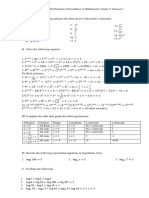Solving Systems of Nonlinear Equations Nonlinear Systems: This Example Can Be Solved by Substitution or Elimination
Uploaded by
wafiullah sayedSolving Systems of Nonlinear Equations Nonlinear Systems: This Example Can Be Solved by Substitution or Elimination
Uploaded by
wafiullah sayedSolving Systems of Nonlinear Equations
Nonlinear Systems
How do you know if you are solving a system of linear equations or a system of nonlinear equations? The
answer to this question is pretty straight forward. If the system contains any exponents, negative exponents,
or radicals, then it is a nonlinear system. A nonlinear system of equation is when we are given an equation
that is not linear. A nonlinear system may consist of a parabola and a circle or an ellipse and a line. The goal
when solving any nonlinear system is to find the point or points of intersection of the two shapes.
Solving Nonlinear Systems
When solving a system of linear equations, we were looking for the point of intersection of two lines and
two lines can only intersect in at most one point (unless you have the same line twice, which has infinite
points of intersection). When solving a system of nonlinear equations, we are still looking to find the point
of intersection of the two equations. However, since we are dealing with curves there can be more than one
point of intersection, which means this type of problem can have multiple solutions.
To solve a system of nonlinear systems, we are limited to three options. The first option is to solve the
system by graphing. Solving by graphing is a great option if you are using a graphing calculator, but if you
are required to do the problem by hand this would not be a good option. The second option is to solve the
system by substitution. The third option is to solve the system by elimination. We will look at solving
systems by using either substitution or elimination. Now let’s look at a few examples of solving systems of
nonlinear equations.
Note: When solving nonlinear systems, it is possible to get extraneous solutions (extra answers), so it is
important to verify that solutions found are in fact correct solutions. We can verify the solutions by plugging
potential solution into the original question.
4x − y = 5
Example 1: Solve This example can be solved by substitution or elimination.
2x 2 − y = 5
Solve for one variable.
4x − y = 5 → y = 4x − 5
Substitute one equation into the other.
2x 2 − y = 5
2x 2 − (4x − 5) = 5
2x 2 − 4x + 5 = 5 Solve for x.
2x − 4x = 0
2
2x(x − 2) = 0
x = 0, 2
Solving Systems of Nonlinear Equations – Pike Page 1 of 4
Use x = 0 and x = 2 to find y.
y = 4x − 5 or y = 4x − 5
= 4(0) − 5 = 4(2) − 5
= −5 =3
The possible solutions written as ordered pairs are (0, –5) and (2, 3). By substituting each ordered pair into
the original question, we can verify both ordered pairs are correct.
x 2 + y 2 = 13
Example 2: Solve This example can be solved by substitution or elimination.
x2 − y = 7
Eliminate x2.
−1(x 2 + y 2 = 13)
Switch numbers in front of x2, we need a negative
1(x − y = 7)
2
sign.
− x 2 − y 2 = −13
+
x2 − y = 7
Add the equations and solve for y.
− y 2 − y = −6
y2 + y − 6 = 0
(y − 2)(y + 3) = 0
y = 2, −3
Use y = 2 and y = –3 to find x.
x 2 − y = 7 or x 2 − y = 7
x2 − 2 = 7 x 2 − (−3) = 7
x2 = 9 x2 = 4
x = 3 x = 2
The possible solutions written as ordered pairs are (3, 2), (–3, 2), (2, –3), and (–2, –3). By substituting each
ordered pair into the original question, we can verify all ordered pairs are correct.
x 2 − y2 = 9
Example 3: Solve This example can be solved by substitution or elimination.
y = x2
Solve for one variable.
y = x2 → x2 = y
Solving Systems of Nonlinear Equations – Pike Page 2 of 4
Substitute one equation into the other.
x 2 − y2 = 9
y − y2 = 9
Solve for y.
y2 − y + 9 = 0
1 −35
y=
2
The value of y is an imaginary number, so there is “No Solution” to the problem.
y= x
Example 4: Solve This example can only be solved by substitution.
y = 2−x elimination.
Solve for one variable.
y = 2−x → y = −x + 2
Substitute one equation into the other.
y= x
−x + 2 = x
( x)
2
(− x + 2) 2 = Solve for x.
x 2 − 4x + 4 = x
x 2 − 5x + 4 = 0
(x − 1)(x − 4) = 0
x = 1, 4
Use x = 1 and x = 4 to find y.
y = − x + 2 or y = −x + 2
y = −(1) + 2 y = −(4) + 2
y =1 y = −2
The possible solutions written as ordered pairs are (1, 1) and (4, –2). By substituting each ordered pair into
the original question, we can verify the only correct ordered pair for both equations is (1, 1).
2x 2 + y2 = 18
Example 5: Solve This example can only be solved by substitution.
xy = 4 elimination.
Solve for one variable.
4
xy = 4 → y =
x
Solving Systems of Nonlinear Equations – Pike Page 3 of 4
Substitute one equation into the other.
2x 2 + y 2 = 18
2
4
2x + = 18
2
x
16
2x 2 + 2 = 18
x
16
x 2 2x 2 + 2 = 18
x Solve for x.
2x 4 + 16 = 18x 2
2x 4 − 18x 2 + 16 = 0
2(x 4 − 9x 2 + 8) = 0
2(x 2 − 1)(x 2 − 8) = 0
x 2 − 1 = 0 or x 2 − 8 = 0
x 2 = 1 or x 2 = 8
x = 1 or x = 2 2
Use x = 1, –1 and x = 2 2, −2 2 to find y.
4 4 4 4
y= or y= or y= or y=
x x x x
4 4 4 4
y= y= y= y=
1 −1 2 2 −2 2
y=4 y = −4 2 −2
y= y=
2 2
2 2 −2 2
y= y=
2 2
y= 2 y=− 2
( ) (
The possible solutions written as ordered pairs are (1, 4), (–1, –4), 2 2, 2 , and −2 2, − 2 . By )
substituting each ordered pair into the original question, we can verify all ordered pairs are correct.
Solving Systems of Nonlinear Equations – Pike Page 4 of 4
You might also like
- PPP Feasibility Study Checklist: Project Name100% (3)PPP Feasibility Study Checklist: Project Name3 pages
- Swot Analysis of Irrigation and Water Supply Management Directorate and One Year Work Plan75% (4)Swot Analysis of Irrigation and Water Supply Management Directorate and One Year Work Plan15 pages
- Tutorial 8 (Chromatograms) Incl Answers - 73No ratings yetTutorial 8 (Chromatograms) Incl Answers - 7320 pages
- Study Guide 1.6 - Systems of Non-Linear EquationNo ratings yetStudy Guide 1.6 - Systems of Non-Linear Equation8 pages
- Learning Activity Sheets-Pre Cal - (Week 1)No ratings yetLearning Activity Sheets-Pre Cal - (Week 1)2 pages
- Atg2 - Precal - 1ST Sem - Sy22-23 - GcesguerraNo ratings yetAtg2 - Precal - 1ST Sem - Sy22-23 - Gcesguerra7 pages
- Lesson 2 Rational Functions, Equations and InequalitiesNo ratings yetLesson 2 Rational Functions, Equations and Inequalities8 pages
- Final Lesson No. 2 (Angles in Standard Position and Coterminal Angles)No ratings yetFinal Lesson No. 2 (Angles in Standard Position and Coterminal Angles)31 pages
- Maloco National High School Final Examination in Basic CalculusNo ratings yetMaloco National High School Final Examination in Basic Calculus3 pages
- LP-BC-Q3L1-Illustrating The Limit of A Function Using A Table of Values and The Graph of The FunctionNo ratings yetLP-BC-Q3L1-Illustrating The Limit of A Function Using A Table of Values and The Graph of The Function3 pages
- Department of Education: Republic of The PhilippinesNo ratings yetDepartment of Education: Republic of The Philippines8 pages
- GenMath Q1 W9 Logarithmic-Functions-and-their-Graphs Elegado Bgo100% (1)GenMath Q1 W9 Logarithmic-Functions-and-their-Graphs Elegado Bgo29 pages
- (Stem - Bc11Lc-Iiia-1) (Stem - Bc11Lc-Iiia-2) (Stem - Bc11Lc-Iiia-3) (Stem - Bc11Lc-Iiia-4)No ratings yet(Stem - Bc11Lc-Iiia-1) (Stem - Bc11Lc-Iiia-2) (Stem - Bc11Lc-Iiia-3) (Stem - Bc11Lc-Iiia-4)6 pages
- 11 Basic Calculus 1st: Session 1 Session 2 Session 3 Session 4No ratings yet11 Basic Calculus 1st: Session 1 Session 2 Session 3 Session 46 pages
- Represent Relations and Functions: For Your NotebookNo ratings yetRepresent Relations and Functions: For Your Notebook8 pages
- GM The Domain, Range, Intercepts, ZeroesNo ratings yetGM The Domain, Range, Intercepts, Zeroes35 pages
- General Mathematics: Quarter 1 - Module 4No ratings yetGeneral Mathematics: Quarter 1 - Module 426 pages
- WSLP-General Mathematics Week 7 - ExponentialNo ratings yetWSLP-General Mathematics Week 7 - Exponential13 pages
- The Derivative As The Slope of The Tangent Line: (At A Point)No ratings yetThe Derivative As The Slope of The Tangent Line: (At A Point)20 pages
- TOS - Final Examination - Statistics and Probability - AY 2020 2021No ratings yetTOS - Final Examination - Statistics and Probability - AY 2020 20211 page
- Quiz # 02 Rational Equation and Rational Inequalities0% (1)Quiz # 02 Rational Equation and Rational Inequalities3 pages
- editedGEN - MATH - Q1 - TOS 60 40 2022 2023No ratings yeteditedGEN - MATH - Q1 - TOS 60 40 2022 20234 pages
- Atg-W1 - Campomanes Statistics & ProbabilityNo ratings yetAtg-W1 - Campomanes Statistics & Probability6 pages
- Guided Generalization For Student Understanding Grade 9 - MathematicsNo ratings yetGuided Generalization For Student Understanding Grade 9 - Mathematics3 pages
- Prepared For: (Name of The Project and The Relevant LM)No ratings yetPrepared For: (Name of The Project and The Relevant LM)2 pages
- Weather, Climate and Water in Afghanistan: A Visual Guide (Atlas) To The National Hydrology and Meteorology ServicesNo ratings yetWeather, Climate and Water in Afghanistan: A Visual Guide (Atlas) To The National Hydrology and Meteorology Services25 pages
- Annex B - TOR of 6 Water Projects in NinvehNo ratings yetAnnex B - TOR of 6 Water Projects in Ninveh7 pages
- Islamic Republic of Afghanistan Ministry of Finance Directorate General PPP Concept Registration FormNo ratings yetIslamic Republic of Afghanistan Ministry of Finance Directorate General PPP Concept Registration Form8 pages
- Process Map For Develoung Nationa L Water PolicyNo ratings yetProcess Map For Develoung Nationa L Water Policy4 pages
- Education Quality Reform in Afghanistan (EQRA) Programs' TA Requirements 2018-2021No ratings yetEducation Quality Reform in Afghanistan (EQRA) Programs' TA Requirements 2018-20212 pages
- Annex A: Technical Application Template: Amanat Afghanistan USAID CONTRACT NUMBER AID-306-H-17-00003No ratings yetAnnex A: Technical Application Template: Amanat Afghanistan USAID CONTRACT NUMBER AID-306-H-17-0000334 pages
- CBM - Infrastructures: Home About Us Advocacy Contact UsNo ratings yetCBM - Infrastructures: Home About Us Advocacy Contact Us6 pages
- National Comprehensive Agriculture Development Priority Program 2016 - 2021No ratings yetNational Comprehensive Agriculture Development Priority Program 2016 - 202145 pages
- Public Participation in Road Network Projects (AF0013) : Skip NavigationNo ratings yetPublic Participation in Road Network Projects (AF0013) : Skip Navigation14 pages
- EQUIP II Additional Financing EPP Final June 19 2012No ratings yetEQUIP II Additional Financing EPP Final June 19 201230 pages
- Kabul Water Conference Hydrogeology Part1 PDFNo ratings yetKabul Water Conference Hydrogeology Part1 PDF21 pages
- ISD Provincial Staff List With Appresal ResultsNo ratings yetISD Provincial Staff List With Appresal Results29 pages
- Anne-1-600 List Updates Follow Up Plan With PMUs and PEDs For HandoverNo ratings yetAnne-1-600 List Updates Follow Up Plan With PMUs and PEDs For Handover4 pages
- Nonlinear Algebraic Equations Example: (In) S I (In) (In) P, INo ratings yetNonlinear Algebraic Equations Example: (In) S I (In) (In) P, I23 pages
- 3 RD Year Civil - General - 2018-2019: (1) Surface Irrigation and DrainageNo ratings yet3 RD Year Civil - General - 2018-2019: (1) Surface Irrigation and Drainage2 pages
- سوالات امتحان ماستری پوهنتون پل تخنیک را بخش هایدرولیک100% (1)سوالات امتحان ماستری پوهنتون پل تخنیک را بخش هایدرولیک18 pages
- S7 - Tarea - Set - B - Termo1202 - Lorena - HenNo ratings yetS7 - Tarea - Set - B - Termo1202 - Lorena - Hen12 pages
- 5 - Lecture 5 - S-Plane To Z-Plane Mapping & Transfer Function - (2nd Term 2021-2022)No ratings yet5 - Lecture 5 - S-Plane To Z-Plane Mapping & Transfer Function - (2nd Term 2021-2022)12 pages
- Construction Performance Management & Resource Optimization: Chapter Four Project Quality ManagementNo ratings yetConstruction Performance Management & Resource Optimization: Chapter Four Project Quality Management41 pages
- Abstract: Wet Cupping Therapy Practitioner and Standard Operating ProceduresNo ratings yetAbstract: Wet Cupping Therapy Practitioner and Standard Operating Procedures14 pages
- Differential Geometry Attacks The Torus William Schulz: Department of Mathematics and StatisticsNo ratings yetDifferential Geometry Attacks The Torus William Schulz: Department of Mathematics and Statistics7 pages
- Department of Mathematics Indian Institute of Technology PatnaNo ratings yetDepartment of Mathematics Indian Institute of Technology Patna8 pages
- Rational Function and Irrational Function: LessonNo ratings yetRational Function and Irrational Function: Lesson15 pages
- Definition: A Function F From A Set A To Set B Is A Rule of Correspondence That Assigns To EachNo ratings yetDefinition: A Function F From A Set A To Set B Is A Rule of Correspondence That Assigns To Each4 pages
- Numerical Solution of Regularized Long-Wave EquationNo ratings yetNumerical Solution of Regularized Long-Wave Equation8 pages
- X X X X X X: Example 3. Given The EquationsNo ratings yetX X X X X X: Example 3. Given The Equations5 pages
- Agency Assessment (30points) : Students Will Produce A 5-7 Page Double-Spaced PaperNo ratings yetAgency Assessment (30points) : Students Will Produce A 5-7 Page Double-Spaced Paper3 pages
- Rayleigh Probability Distribution Applied To Random Wave HeightsNo ratings yetRayleigh Probability Distribution Applied To Random Wave Heights3 pages
- Swot Analysis of Irrigation and Water Supply Management Directorate and One Year Work PlanSwot Analysis of Irrigation and Water Supply Management Directorate and One Year Work Plan
- Lesson 2 Rational Functions, Equations and InequalitiesLesson 2 Rational Functions, Equations and Inequalities
- Final Lesson No. 2 (Angles in Standard Position and Coterminal Angles)Final Lesson No. 2 (Angles in Standard Position and Coterminal Angles)
- Maloco National High School Final Examination in Basic CalculusMaloco National High School Final Examination in Basic Calculus
- LP-BC-Q3L1-Illustrating The Limit of A Function Using A Table of Values and The Graph of The FunctionLP-BC-Q3L1-Illustrating The Limit of A Function Using A Table of Values and The Graph of The Function
- Department of Education: Republic of The PhilippinesDepartment of Education: Republic of The Philippines
- GenMath Q1 W9 Logarithmic-Functions-and-their-Graphs Elegado BgoGenMath Q1 W9 Logarithmic-Functions-and-their-Graphs Elegado Bgo
- (Stem - Bc11Lc-Iiia-1) (Stem - Bc11Lc-Iiia-2) (Stem - Bc11Lc-Iiia-3) (Stem - Bc11Lc-Iiia-4)(Stem - Bc11Lc-Iiia-1) (Stem - Bc11Lc-Iiia-2) (Stem - Bc11Lc-Iiia-3) (Stem - Bc11Lc-Iiia-4)
- 11 Basic Calculus 1st: Session 1 Session 2 Session 3 Session 411 Basic Calculus 1st: Session 1 Session 2 Session 3 Session 4
- Represent Relations and Functions: For Your NotebookRepresent Relations and Functions: For Your Notebook
- The Derivative As The Slope of The Tangent Line: (At A Point)The Derivative As The Slope of The Tangent Line: (At A Point)
- TOS - Final Examination - Statistics and Probability - AY 2020 2021TOS - Final Examination - Statistics and Probability - AY 2020 2021
- Quiz # 02 Rational Equation and Rational InequalitiesQuiz # 02 Rational Equation and Rational Inequalities
- Guided Generalization For Student Understanding Grade 9 - MathematicsGuided Generalization For Student Understanding Grade 9 - Mathematics
- Prepared For: (Name of The Project and The Relevant LM)Prepared For: (Name of The Project and The Relevant LM)
- Weather, Climate and Water in Afghanistan: A Visual Guide (Atlas) To The National Hydrology and Meteorology ServicesWeather, Climate and Water in Afghanistan: A Visual Guide (Atlas) To The National Hydrology and Meteorology Services
- Islamic Republic of Afghanistan Ministry of Finance Directorate General PPP Concept Registration FormIslamic Republic of Afghanistan Ministry of Finance Directorate General PPP Concept Registration Form
- Education Quality Reform in Afghanistan (EQRA) Programs' TA Requirements 2018-2021Education Quality Reform in Afghanistan (EQRA) Programs' TA Requirements 2018-2021
- Annex A: Technical Application Template: Amanat Afghanistan USAID CONTRACT NUMBER AID-306-H-17-00003Annex A: Technical Application Template: Amanat Afghanistan USAID CONTRACT NUMBER AID-306-H-17-00003
- CBM - Infrastructures: Home About Us Advocacy Contact UsCBM - Infrastructures: Home About Us Advocacy Contact Us
- National Comprehensive Agriculture Development Priority Program 2016 - 2021National Comprehensive Agriculture Development Priority Program 2016 - 2021
- Public Participation in Road Network Projects (AF0013) : Skip NavigationPublic Participation in Road Network Projects (AF0013) : Skip Navigation
- EQUIP II Additional Financing EPP Final June 19 2012EQUIP II Additional Financing EPP Final June 19 2012
- Anne-1-600 List Updates Follow Up Plan With PMUs and PEDs For HandoverAnne-1-600 List Updates Follow Up Plan With PMUs and PEDs For Handover
- Nonlinear Algebraic Equations Example: (In) S I (In) (In) P, INonlinear Algebraic Equations Example: (In) S I (In) (In) P, I
- 3 RD Year Civil - General - 2018-2019: (1) Surface Irrigation and Drainage3 RD Year Civil - General - 2018-2019: (1) Surface Irrigation and Drainage
- سوالات امتحان ماستری پوهنتون پل تخنیک را بخش هایدرولیکسوالات امتحان ماستری پوهنتون پل تخنیک را بخش هایدرولیک
- 5 - Lecture 5 - S-Plane To Z-Plane Mapping & Transfer Function - (2nd Term 2021-2022)5 - Lecture 5 - S-Plane To Z-Plane Mapping & Transfer Function - (2nd Term 2021-2022)
- Construction Performance Management & Resource Optimization: Chapter Four Project Quality ManagementConstruction Performance Management & Resource Optimization: Chapter Four Project Quality Management
- Abstract: Wet Cupping Therapy Practitioner and Standard Operating ProceduresAbstract: Wet Cupping Therapy Practitioner and Standard Operating Procedures
- Differential Geometry Attacks The Torus William Schulz: Department of Mathematics and StatisticsDifferential Geometry Attacks The Torus William Schulz: Department of Mathematics and Statistics
- Department of Mathematics Indian Institute of Technology PatnaDepartment of Mathematics Indian Institute of Technology Patna
- Definition: A Function F From A Set A To Set B Is A Rule of Correspondence That Assigns To EachDefinition: A Function F From A Set A To Set B Is A Rule of Correspondence That Assigns To Each
- Numerical Solution of Regularized Long-Wave EquationNumerical Solution of Regularized Long-Wave Equation
- Agency Assessment (30points) : Students Will Produce A 5-7 Page Double-Spaced PaperAgency Assessment (30points) : Students Will Produce A 5-7 Page Double-Spaced Paper
- Rayleigh Probability Distribution Applied To Random Wave HeightsRayleigh Probability Distribution Applied To Random Wave Heights























































































































